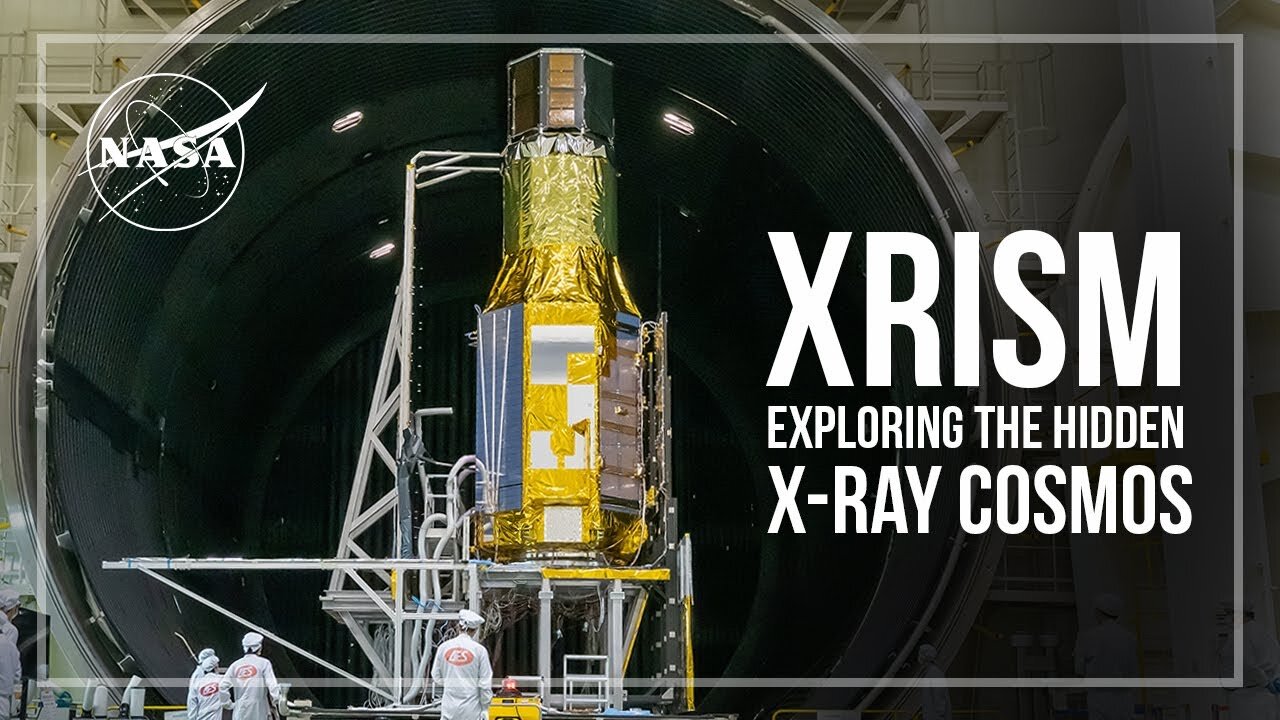Premium Only Content

XRISM: Exploring the Hidden X-ray Cosmos
Watch this video to learn more about XRISM (X-ray Imaging and Spectroscopy Mission), a collaboration between JAXA (Japan Aerospace Exploration Agency) and NASA.
Credit: NASA's Goddard Space Flight Center
Music Credits: Universal Production Music
Lights On by Hugh Robert Edwin Wilkinson
Dreams by Jez Fox and Rohan Jones
Changing Tide by Rob Manning
Wandering Imagination by Joel Goodman
A powerful satellite called XRISM (X-ray Imaging and Spectroscopy Mission) is set to provide astronomers with a revolutionary look at the X-ray sky.
XRISM is led by JAXA (Japan Aerospace Exploration Agency) in collaboration with NASA and with contributions from ESA (European Space Agency).
XRISM detects X-rays with energies ranging from 400 to 12,000 electron volts. (For comparison, the energy of visible light is 2 to 3 electron volts.)
This range will provide astrophysicists with new information about some of the universe’s hottest regions, largest structures, and objects with the strongest gravity.
The mission has two instruments, Resolve and Xtend.
Resolve is a microcalorimeter spectrometer developed in collaboration between JAXA and NASA. When an X-ray hits Resolve’s 6-by-6-pixel detector, its energy causes a tiny increase in temperature. By measuring each individual X-ray’s energy, the instrument provides information about the source, such as its composition, motion, and physical state.
To detect these tiny temperature changes, Resolve must operate at just a fraction of a degree above absolute zero. It reaches this state in orbit after a multistage mechanical cooling process inside a refrigerator-sized container of liquid helium.
XRISM’s second instrument, Xtend, was developed by JAXA. It will give XRISM one of the largest fields of view of any X-ray imaging satellite flown to date, observing an area about 60% larger than the average apparent size of the full moon. The images it collects will complement the data collected by Resolve.
Each instrument is at the focus of an XMA (X-ray Mirror Assembly) designed and developed at Goddard.
X-ray wavelengths are so short, they can pass straight between the atoms of the dish-shaped mirrors used to capture visible, infrared, and ultraviolet light.
Instead, X-ray astronomers use nested curved mirrors turned on their sides. The X-rays skip off the surfaces like stones across a pond and into the detectors.
Each of XRISM’s XMAs houses hundreds of concentric, precisely shaped aluminum shells built in quadrants and assembled into a circle. In all, there are over 3,200 individual mirror segments in the two mirror assemblies.
After launch, XRISM will begin a months-long calibration phase, during which Resolve will reach its operating temperature.
In Unison by Samuel Sim
While the video in its entirety can be shared without permission,
the music and some individual imagery may have been obtained through permission and may not be excised or remixed in other products.
Specific details on such imagery may be found here:
https://svs.gsfc.nasa.gov/14405/
For more information on NASA’s media guidelines, visit https://nasa.gov/multimedia/guidelines.
If you liked this video, subscribe to the NASA Goddard YouTube channel: https://www.youtube.com/NASAGoddard
Follow NASA’s Goddard Space Flight Center ·
Instagram http://www.instagram.com/nasagoddard ·
Twitter http://twitter.com/NASAGoddard ·
Twitter http://twitter.com/NASAGoddardPix ·
Facebook: http://www.facebook.com/NASAGoddard ·
Flickr http://www.flickr.com/photos/gsfc
-
 13:00
13:00
Dermatologist Dr. Dustin Portela
9 hours ago $0.74 earnedAnother Insurance Company Harming Patients - Doctor Explains
6.12K1 -
 52:32
52:32
Survive History
16 hours ago $0.93 earnedCould You Survive in King George's Redcoats During the Jacobite Rising?
4.13K3 -
 17:53
17:53
Fit'n Fire
14 hours ago $0.41 earnedA Rifle for the Family -- BCM MK2 BFH and Gunnr Optics Odin 1-10x28mm LPVO
3.83K2 -
 1:03:52
1:03:52
GrassRootsWarriorNetwork
1 month agoWe The People Are The News Now While MSM Is On It’s Way Out - YourNews.com with Sam Anthony
4.45K -
 21:12
21:12
DeVory Darkins
9 hours ago $12.32 earnedGavin Newsom gets what he deserves after NBC Reporter FACT CHECKS his Lies
30.1K44 -
 1:57:13
1:57:13
MyronGainesX
9 hours agoFormer Fed Explains Sting That Led To The Murder Of A State Trooper
63K18 -
 3:56:27
3:56:27
Due Dissidence
16 hours agoNewsom ROASTED For Pod Save Interview, Candace Owens CALLS OUT Elon, Ian Carroll RATIOES Israel Post
64K50 -
 2:16:17
2:16:17
TheSaltyCracker
8 hours agoLooters Descend on LA ReeEEeE Stream 01-12-25
132K262 -
 40:32
40:32
Man in America
12 hours agoRockefeller Medicine COLLAPSES as God's Natural Healing Takes Over w/ Angie Tomky
41.2K15 -
 2:03:30
2:03:30
Nerdrotic
9 hours ago $6.10 earnedMysteries of Egypt with The Brothers of the Serpent | Forbidden Frontier #087
48.6K3